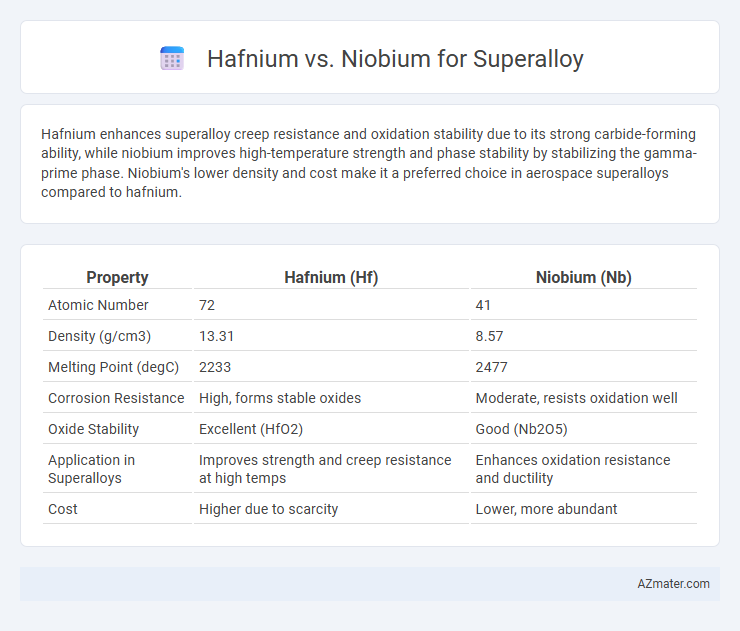Hafnium enhances superalloy creep resistance and oxidation stability due to its strong carbide-forming ability, while niobium improves high-temperature strength and phase stability by stabilizing the gamma-prime phase. Niobium's lower density and cost make it a preferred choice in aerospace superalloys compared to hafnium.
Table of Comparison
| Property | Hafnium (Hf) | Niobium (Nb) |
|---|---|---|
| Atomic Number | 72 | 41 |
| Density (g/cm3) | 13.31 | 8.57 |
| Melting Point (degC) | 2233 | 2477 |
| Corrosion Resistance | High, forms stable oxides | Moderate, resists oxidation well |
| Oxide Stability | Excellent (HfO2) | Good (Nb2O5) |
| Application in Superalloys | Improves strength and creep resistance at high temps | Enhances oxidation resistance and ductility |
| Cost | Higher due to scarcity | Lower, more abundant |
Introduction to Superalloys
Superalloys are high-performance metal alloys designed to withstand extreme environments, particularly in aerospace and power generation applications. Hafnium and niobium are critical alloying elements in superalloys, with hafnium enhancing creep resistance and grain boundary strength, while niobium improves corrosion resistance and phase stability. The distinct properties of hafnium and niobium significantly influence the mechanical performance and longevity of superalloys under high-temperature conditions.
Overview of Hafnium and Niobium
Hafnium and niobium are critical elements used in superalloys for high-temperature and corrosion-resistant applications, particularly in aerospace and power generation industries. Hafnium is valued for its excellent oxidation resistance and ability to improve creep strength in superalloys, while niobium enhances mechanical strength and provides superior ductility and thermal stability. Both elements contribute uniquely to the microstructural stability of superalloys, making them indispensable for advanced turbine engines and gas turbines.
Chemical and Physical Properties Comparison
Hafnium exhibits a higher melting point (2233degC) compared to niobium (2477degC), making it more suitable for high-temperature superalloy applications requiring thermal stability. Chemically, hafnium shows superior oxidation resistance and forms a stable oxide layer, enhancing corrosion resistance in aggressive environments, whereas niobium offers better ductility and lower density (8.57 g/cm3 vs. hafnium's 13.31 g/cm3). Both elements contribute to strengthening mechanisms in superalloys, with hafnium improving creep resistance and niobium enhancing grain boundary cohesion.
Melting Points and Thermal Stability
Hafnium exhibits a melting point of approximately 2233degC, significantly higher than niobium's melting point around 2477degC, making niobium superior in terms of thermal endurance for superalloys. Hafnium enhances thermal stability by forming stable carbides and oxides, contributing to improved creep resistance and oxidation resistance at elevated temperatures in superalloys. Niobium's refractory nature and ability to strengthen grain boundaries also make it crucial for maintaining mechanical integrity under extreme thermal conditions in aerospace and turbine applications.
Effects on Superalloy Mechanical Strength
Hafnium significantly enhances the mechanical strength of superalloys by improving grain boundary cohesion and increasing creep resistance, critical for high-temperature applications. Niobium contributes to solid solution strengthening and promotes the formation of stable carbide precipitates, which improve tensile strength and fatigue resistance. The combined use of hafnium and niobium in superalloys synergistically refines microstructure and optimizes mechanical performance under extreme thermal and mechanical stress.
Oxidation and Corrosion Resistance
Hafnium significantly enhances oxidation resistance in superalloys by forming a stable, protective oxide layer that slows degradation at high temperatures, outperforming niobium in this regard. Niobium improves corrosion resistance by strengthening the alloy's matrix but tends to form less protective oxides compared to hafnium, leading to reduced longevity under extreme oxidative environments. Combining hafnium with niobium can optimize superalloy performance, balancing excellent oxidation resistance with structural integrity in corrosive and high-temperature applications.
Influence on Creep Resistance
Hafnium significantly enhances the creep resistance of superalloys by forming stable HfC carbides that pin grain boundaries and inhibit dislocation movement at high temperatures. Niobium contributes to creep strength primarily through the formation of g' (gamma prime) precipitates, which strengthen the alloy matrix by hindering dislocation glide. Hafnium's grain boundary strengthening effects generally surpass niobium's precipitate hardening, making Hf particularly effective in improving long-term creep performance in high-temperature superalloys.
Cost and Availability Considerations
Hafnium is significantly rarer than niobium, leading to higher costs and limited availability in superalloy applications. Niobium's abundance and more stable supply chain make it a cost-effective choice for industrial-scale production. Cost-efficiency and procurement reliability often drive the preference for niobium despite hafnium's superior high-temperature properties.
Industrial Applications in Superalloys
Hafnium enhances superalloys by improving creep resistance and oxidation stability, key for jet engine components and gas turbines operating at extreme temperatures. Niobium contributes to superalloy strength through precipitation hardening, optimizing materials used in aerospace and power generation industries. Industrial applications leverage the unique properties of hafnium and niobium alloys to extend component lifespan and performance under harsh thermal and mechanical stresses.
Conclusion: Choosing Between Hafnium and Niobium
Hafnium enhances superalloys by improving creep resistance, oxidation stability, and mechanical strength at high temperatures, making it ideal for turbine blades and aerospace applications. Niobium contributes to increased toughness, phase stability, and corrosion resistance in superalloys, benefiting components exposed to thermal cycling and mechanical stress. Selecting between hafnium and niobium depends on the specific application requirements, with hafnium preferred for high-temperature stability and niobium favored for toughness and corrosion resistance.

Infographic: Hafnium vs Niobium for Superalloy
 azmater.com
azmater.com